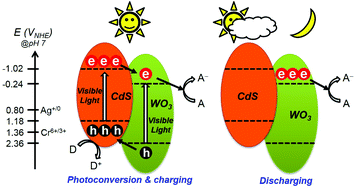Harnessing and storing visible light using a heterojunction of WO3 and CdS for sunlight-free catalysis†
Abstract
CdS and WO3 (CdS/WO3) bilayer film electrodes are fabricated to harness solar visible light (λ > 420 nm) and store photogenerated electrons for possible use during periods of unavailable sunlight. The overall film thickness is approximately 50–60 μm, while the CdS underlayer is slightly thinner than WO3 owing to a packing effect. The energetics of CdS and WO3 determined by optical and electrochemical analyses enables cascaded electron transfer from CdS to WO3. The open circuit potential (EOCP) of CdS/WO3 under visible light (approximately −0.35 V vs. SCE) is nearly maintained even in the absence of light, with a marginal decrease (∼0.15 V) in ∼20 h of darkness. Neither CdS nor WO3 alone exhibits such behavior. The electron lifetimes (τ) of CdS and WO3 are each less than 100 s, whereas coupling of the two increases τ to ∼2500 s at the EOCP. In the absence of dissolved O2, τ further increases, suggesting that O2 is the primary electron acceptor. In spite of oxic conditions, CdS/WO3 is capable of continuously reducing Cr6+ to Cr3+ and Ag+ to Ag0 after removal of visible light. The number of utilized (i.e., stored) electrons in the reductions of Cr6+ and Ag+ are estimated to be ∼1.08 × 1017 and ∼0.87 × 1017, respectively. The primary role of CdS is to be a visible-light absorber in the 420–565 nm wavelength range, transferring the photogenerated electrons to WO3. The electrons stored in WO3 are gradually released to electron acceptors with suitable redox potentials.


 Please wait while we load your content...
Please wait while we load your content...